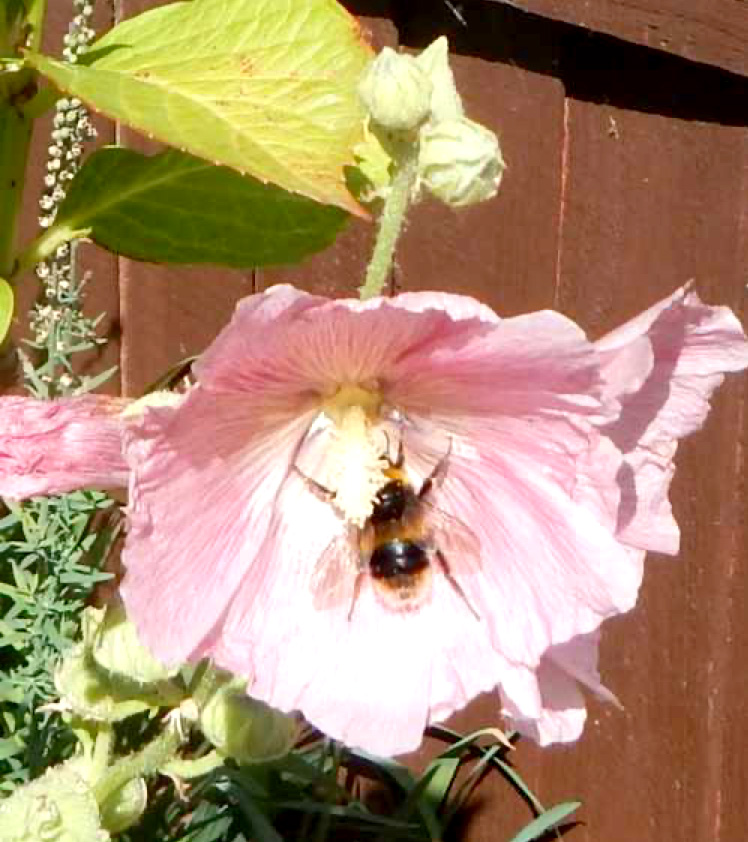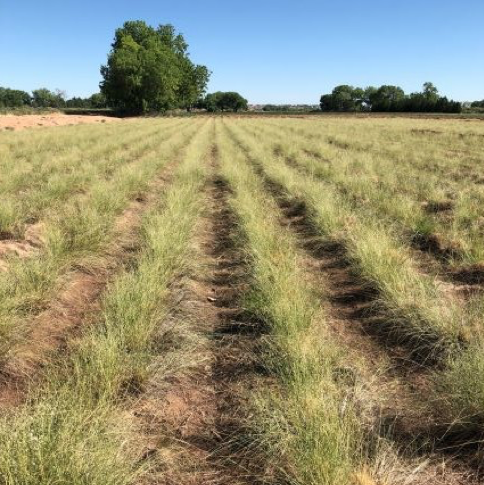by Edna Loehman
On a recent morning I saw and heard:
The biggest black fuzzy bumblebee I had ever seen – about the size of a hummingbird!
Many kinds of bees feasting on hollyhock pollen.
A parent finch feeding a nearly grown baby on the telephone line.
Many white butterflies and a swallow tail butterfly drifting through.
A rabbit munching my kale.
A thrasher dive-bombing my patio on the way to its cactus nest.
A cactus wren eating agave flowers.
Many birds (mostly sparrows and doves) singing.
And most exciting of all, a sharp-shinned hawk watching newly hatched sparrows.

How did all this garden richness come about? Partly it came from the previous owners of the house I bought three years ago and partly from my own gardening efforts since.
I have a typical older adobe style house on an ordinary lot in this area. It has many cacti and agave in the front yard, and in the back, a lot of purple flowering plants and green-growing fruit trees. There is no grass, just wood chips to cover the non-planted garden soil. To this space I have added several garden areas with herbs, veggies, and more native plants, most colored purple and red favored by hummingbirds. Many hollyhocks have emerged as volunteers and the variety in colors is amazing. And of course volunteer sunflowers are also re-seeding themselves annually.
I love that flowers and herbs are mixed with the veggies in my garden and now I am more purposely trying to achieve a backyard wildlife garden, that is, a garden specifically designed to attract birds and bees. One of my garden goals is to see more hummingbirds which only come occasionally now.
At the Plants of the Southwest store, which specializes in native plants, I found a flyer for the ABQ Backyard Refuge Program: see https://friendsofvalledeoro.org/abq-backyard-refuge/ for more detailed information. The flyer lists ways to attract wildlife to your garden. While I had planted nice native plants, I had not done all these, but now I am! Here are some in brief:
- Plant native plants: Insects and birds have evolved with native plants, and native plants are adapted to our habitat and weather.
- Water is a wildlife magnet: all animals and insects need water. Water can be changed regularly to avoid breeding mosquitos.
- Leave garden litter to provide habitat for many species: Butterflies need leaves to lay their eggs. Lizards need litter to hide from hawks. Insects need cover from hot soil. Birds perch on many levels of branches, so dead branches can be helpful. Seed heads provide food for birds.
- Avoid Pesticides: It is well known that pesticides are a cause for bee decline, threatening pollination of important fruits and crops. But also insects are a source of food for birds, also in decline in urban areas. https://www.sciencedaily.com/releases/2022/09/220929132622.htm#:~:text=The%20fact%20that%20an%20urban,are%20fewer%20insects%2C%20for%20example.
Pests like aphids provide food for baby hummingbirds. Weeds such as dandelions are early sources of pollen for pollinating insects.
The advice about leaving litter, weeds, and pests disturbed me at first. But the reward is in experiencing the richness in life’s creatures. Shouldn’t we be able to tolerate a bit of loss in our urban gardens? Do we have to be neat freaks in our whole garden? Now the remote part of my backyard is messy with pecan leaf mulch, dead branches, last year’s sunflower heads and stalks, etc. But I have lots of lizards, and lizards are good hawk food! I am even learning to tolerate a recent rabbit visitor eating part of my chard (and also hollyhock leaves), because I have so much!
I do need to add to my habitat some better water sources for birds, insects, and lizards (different height levels for each). A good source for designing water in the garden is Albuquerque Water Gardens: https://albuquerquewatergardens.com/
A backyard wildlife garden is obviously a work in process – we learn as we go. As we are amazed with the things we notice, we seek to learn more about what we see. What kind of lizards live here? What are the names of birds? How amazing it is that parent birds care for their offspring even after they leave the nest. What eats what (roaches?) We see that the thrashers come to accept us as we quietly watch them in their life cycle. And as we learn, we begin to feel like we are a part of our backyard world, and more importantly part of the larger natural world.



